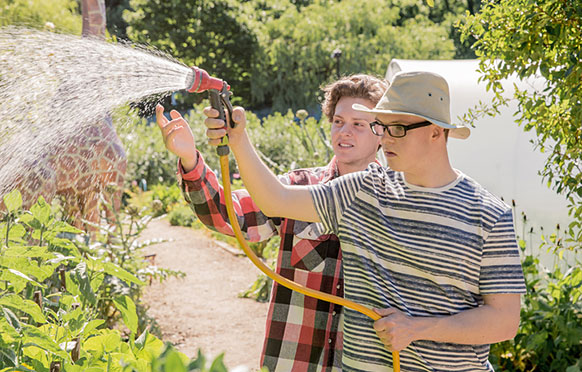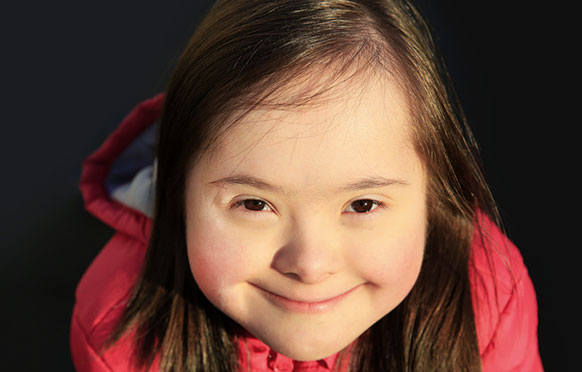
According to the Centers for Disease Control and Prevention, more than six million individuals in the United States have developmental disabilities. About one in six children between the ages of 3 and 17 in the U.S. has one or more developmental disabilities or developmental delays. Developmental disabilities include learning disabilities, attention deficit hyperactivity disorder (ADHD), autism spectrum disorder, intellectual disability, and others.
To better serve this population, it is important for professionals and volunteers to gain an understanding of the characteristics and needs of people living with disabilities.
Training Available
Training is available for Extension staff and volunteers, formal and non-formal educators, community organization staff, caregivers, and other individuals who provide programming and/or support for youth and adults with developmental disabilities. The Skillfully Working with People with Disabilities training series is available online through a partnership with Colorado State University. Download a printable flyer (PDF).
The Skillfully Working with People with Developmental Disabilities training series, developed by faculty of Rutgers Cooperative Extension/New Jersey Agricultural Experiment Station and available through Colorado State University Online, consists of five online courses that provide the foundational knowledge for teaching, assisting, and working with people with disabilities. The series also helps participants learn how to identify different behavioral patterns and implement effective strategies to manage the educational setting. The courses may be taken individually or as a five-course series.
For more information, please contact:
Kelly Dziak
Email: dziak@njaes.rutgers.edu
Online Course Descriptions
HSBB 2501: Overview of Disabilities
The introductory course in this series focuses on six of the most common developmental disabilities, a group of conditions caused by cognitive or physical impairments that can affect learning, language, and behavior.
Participants in this course will:
HSBB 2502: Disabilities and Learning
Every person has the potential to learn, and we all learn differently. The job of educators is to discover and maximize that potential. This course teaches you how to discover potential through focusing on visual, auditory, and kinesthetic learning styles, as well as the relationship between developmental disabilities and learning styles. Each learning style requires different teaching and facilitation techniques. Developing an understanding of these techniques can be invaluable for educators, trainers, service providers, and parents.
HSBB 2503: Understanding and Managing Behavior
Individuals with developmental disabilities can have many strengths, but they may also exhibit challenging, problematic, or unfamiliar behaviors. Working with these individuals requires an understanding of common behavioral triggers, the root causes of challenging behaviors, and the skills needed to manage them. To be an effective facilitator or communicator, it 's critical that problematic behaviors are addressed and managed effectively. This course focuses on understanding, managing, and preventing these behaviors.
Participants in this course will learn:
HSBB 2504: Visual Supports
Learning styles can often be grouped into three categories: visual, auditory, and kinesthetic. Many individuals with developmental disabilities are visual learners, meaning they usually understand what they see better than what they hear. When working with individuals with developmental disabilities, it's recommended that you use visual supports or cues to aid in communication and increase understanding. When working with adults or youth, it 's important to understand the visual learning style, including how and why visual supports help individuals achieve greater learning success. Using visual supports can also be helpful for managing challenging behaviors and reducing anxiety.
Visual support often refers to using imagery or other visual aids to communicate with an individual who has difficulty understanding or using language. Visual supports, from body movements to environmental cues, can enhance the communication process. In this course, you will learn about creating visual supports and how to conduct a visual inventory of your setting in order to determine whether additional visual cues are needed.
HSBB 2505: Understanding Disabilities Laws and Making Program Adaptations
When planning and delivering programming or services for individuals with developmental disabilities, it's important to understand the legal protections afforded to these individuals and learn how to make the necessary accommodations. This course provides information on how to make the accommodations and modifications needed for successful participation in the learning environment, and meet requirements of The Americans with Disabilities Act and The Rehabilitation Act of 1973. You will also learn the difference between an accommodation and modification, and learn tips to help improve communication and information gathering.
Extension Publications
Overview of Developmental Disabilities (FS1284)
More than six million individuals in the United States have developmental disabilities. About one in six children between the ages of 3 and 17 in the U.S. has one or more developmental disabilities or developmental delays. Children are diagnosed as having developmental delays when they do not reach their developmental milestones (functional skills or age-specific tasks that most children can do at a certain age range) at the expected times. Delays can occur in one or many areas including gross or fine motor, language, social, or thinking skills.
Developmental disabilities are a group of conditions due to impairment in physical, learning, language, or behavior areas.
This fact sheet provides a summary of common developmental disabilities and descriptions of their characteristics.
Disabilities and Learning (FS1285)
Developmental disabilities are a group of conditions due to cognitive or physical impairments affecting learning, language, or behavior. Developmental disabilities occur before the age of 22, and substantially limit the individual in one or more major life activities such as understanding and expressive language; learning; self-direction; and motivation.
We are learn differently and everyone uses multiple ways to give, receive, and store information. There are three main learning styles: visual, auditory, and kinesthetic. People generally have one preferred learning style over another. Each learning style requires different teaching and facilitation techniques. In a heterogeneous group of learners, it is important to incorporate a variety of teaching techniques to engage everyone regardless of their learning style.
This fact sheet will help you to understand how individuals learn and what teaching techniques best fit their needs.
Understanding and Managing Behavior (FS1286)
Individuals with developmental disabilities have many strengths and abilities, but can at times exhibit challenging, problematic, or unfamiliar behaviors.
All behaviors, even a negative or problematic behavior, serve a purpose for the individual. They are a way of letting us know that there is an unmet need. The most common triggers for problematic behavior are difficulty transitioning through activities; not understanding directions; frustration; lack of structure; and sensory overload. Problematic behavior is categorized into three types: attention-seeking, work avoidance, escape or sensory overload. Working with individuals with developmental disabilities requires an understanding of the common triggers and meaning of challenging behaviors, and the skill set needed to manage them.
This fact sheet will provide information on types and common triggers of problematic behavior as well as provide some techniques to help you manage behavior.
Visual Supports (FS1287)
There are three basic learning styles: Visual, Auditory, and Kinesthetic. Visual learners learn better by watching rather than listening and tend to remember details better that they can see.
Like many people, individuals with developmental disabilities are visual learners and learn better with visual supports. When working with both adult and youth audiences, it is important to understand the visual learning style as well as how and why visual supports help individuals to be more successful in the learning environment. Visual supports can be helpful in managing behavior and reducing anxiety as individuals transition between activities, schedules, or settings.
This fact sheet will provide an overview of how to conduct visual inventories and utilize visual supports to enhance learning.
Disabilities Laws and Program Accommodations and Modifications (FS1288)
When planning and delivering programs for clientele with developmental disabilities it is important for educators to understand the legal protections due these individuals and to learn how to make the accommodations and modifications needed for successful participation. A disability is a mental or physical impairment that substantially limits one or more major life activities. Inclusion means to involve individuals with special needs in the same clubs, events, and programs as individuals without special needs.
The Americans with Disabilities Act enables society to benefit from the skills and talents of individuals with disabilities and guarantees equal opportunity.
This fact sheet provides an overview of disabilities laws and methods to modify the project or activity, program requirements or physical environment to accommodate the needs of the clientele.



